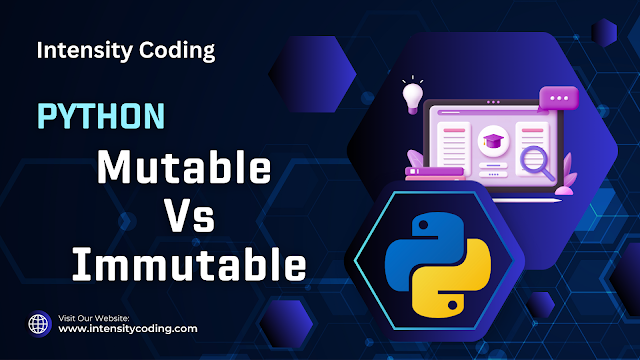Python Mutable vs Immutable Objects¶
- In Python, data types can be categorized as either mutable or immutable.
- An immutable object can’t be changed after it is created.
| Class | Description | Immutable |
|---|---|---|
| bool | Boolean value | Yes |
| int | integer | Yes |
| float | floating-point number | Yes |
| list | mutable sequence of object | No |
| tuple | immutable sequence of object | Yes |
| str | character string | Yes |
| set | unordered set of distinct objects | No |
| frozenset | immutable form of set class | Yes |
| dict | associative mapping | NO |
Python Immutable Data Types:¶
- Numbers (int, float, complex): Numeric data types are immutable. When you perform operations that change their value, a new object is created in memory.
In [ ]:
x = 10
y = x # y references the same 10
print("id of x: ",id(x))
print("id of y: ", id(y))
x += 1 # Now x is 11, a new object is created
print("New id of x: ",id(x))
id of x: 10751144 id of y: 10751144 New id of x: 10751176
- Strings: Strings are immutable. You can't change the characters of a string once it's created. When you modify a string, a new string is created.
In [ ]:
my_str = "Intensity"
print("id of my_str: ",id(my_str))
my_str += " Coding" # Creates a new string with "Intensity Coding"
print("New id of my_str: ",id(my_str))
id of my_str: 137843795649776 New id of my_str: 137843795581712
- Tuples: Tuples are also immutable. You can't change their elements after creation.
In [ ]:
my_tuple = (1, 2, 3)
# This is not allowed: my_tuple[0] = 10
Python Mutable Data Types:¶
- Lists: Lists are mutable. You can change, add, or remove elements from a list after creation.
In [ ]:
my_list = [1, 2, 3]
my_list.append(4) # Modifies the list in place
print(my_list)
[1, 2, 3, 4]
- Dictionaries: Dictionaries are mutable. You can modify the key-value pairs in a dictionary.
In [ ]:
my_dict = {'name': 'Raj', 'age': 35}
my_dict['age'] = 31 # Changes the 'age' value
print(my_dict)
{'name': 'Raj', 'age': 31}
- Sets: Sets are mutable. You can add or remove elements from a set.
In [ ]:
my_set = {1, 2, 3}
my_set.add(4) # Modifies the set to include 4
print(my_set)
{1, 2, 3, 4}
Python Collections¶
- There are four collection data types in the Python programming language:
1. List
- Lists are ordered and mutable(changeable) collections of data.
- Allows duplicate members.
- They are created using square brackets
[ ].
In [ ]:
my_list = [1, 2, 3, 4, 5]
2. Tuple
- Tuples are ordered and immutable(unchangeable) collections of data.
- Allows duplicate members.
- They are created using parentheses
( ).
In [ ]:
my_tuple = (1, 2, 3, 4, 5)
3. Set
- Sets are unordered collections of unique elements which is unchangeable and unindexed.
- No duplicate members.
- Set items are unchangeable, but you can remove and/or add items whenever you like.
- They are created using curly braces
{ }or with the set() constructor.
In [ ]:
my_set = {1, 2, 3, 4, 5}
4. Dictionary
- Dictionaries are collections of key-value pairs.
- It is ordered and changeable.
- No duplicate members.
- They are created using curly braces
{ }with key-value pairs.
In [ ]:
my_dict = {"name": "Raj", "age": 35, "city": "Jaipur"}
